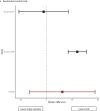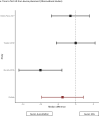Fast and accurate newborn heart rate monitoring at birth: A systematic review
- PMID: 38912532
- PMCID: PMC11190559
- DOI: 10.1016/j.resplu.2024.100668
Fast and accurate newborn heart rate monitoring at birth: A systematic review
Abstract
Aim: To examine speed and accuracy of newborn heart rate measurement by various assessment methods employed at birth.
Methods: A search of Medline, SCOPUS, CINAHL and Cochrane was conducted between January 1, 1946, to until August 16, 2023. (CRD 42021283364) Study selection was based on predetermined criteria. Reviewers independently extracted data, appraised risk of bias and assessed certainty of evidence.
Results: Pulse oximetry is slower and less precise than ECG for heart rate assessment. Both auscultation and palpation are imprecise for heart rate assessment. Other devices such as digital stethoscope, Doppler ultrasound, an ECG device using dry electrodes incorporated in a belt, photoplethysmography and electromyography are studied in small numbers of newborns and data are not available for extremely preterm or bradycardic newborns receiving resuscitation. Digital stethoscope is fast and accurate. Doppler ultrasound and dry electrode ECG in a belt are fast, accurate and precise when compared to conventional ECG with gel adhesive electrodes.
Limitations: Certainty of evidence was low or very low for most comparisons.
Conclusion: If resources permit, ECG should be used for fast and accurate heart rate assessment at birth. Pulse oximetry and auscultation may be reasonable alternatives but have limitations. Digital stethoscope, doppler ultrasound and dry electrode ECG show promise but need further study.
Keywords: Auscultation; Bradycardia; Digital stethoscope; Doppler ultrasound; Dry electrode ECG; Electrocardiogram; Heart Rate; ILCOR; Meta-analysis; NRP; Newborn; Palpation; Pulse oximeter; Resuscitation; Systematic review.
© 2024 The Author(s).
Conflict of interest statement
The authors declare the following financial interests/personal relationships which may be considered as potential competing interests: ‘Dr. Kapadia is a co-author of one of the studies included in this review. Drs. Liley and Rabi are editorial board members for the Resuscitation Plus journal. The other authors have no conflicts to disclose.’.
Figures







References
-
- Wyckoff M.H., Greif R., Morley P.T., et al. 2022 International Consensus on Cardiopulmonary Resuscitation and Emergency Cardiovascular Care Science With Treatment Recommendations: Summary From the Basic Life Support; Advanced Life Support; Pediatric Life Support; Neonatal Life Support; Education, Implementation, and Teams; and First Aid Task Forces. Circulation. 2022;146:e483–e557. - PubMed
-
- Ersdal H.L., Mduma E., Svensen E., Perlman J.M. Early initiation of basic resuscitation interventions including face mask ventilation may reduce birth asphyxia related mortality in low-income countries: a prospective descriptive observational study. Resuscitation. 2012;83:869–873. - PubMed
-
- Kapadia P., Hurst C., Harley D., et al. Trends in neonatal resuscitation patterns in Queensland, Australia - A 10-year retrospective cohort study. Resuscitation. 2020;157:126–132. - PubMed
-
- Cavallin F., Cori M.S., Negash S., et al. Heart rate determination in newborns at risk for resuscitation in a low-resource setting: a randomized controlled trial. J Pediatr. 2020;221:88–92.e1. - PubMed
-
- Johnson P.A., Cheung P.Y., Lee T.F., O'Reilly M., Schmolzer G.M. Novel technologies for heart rate assessment during neonatal resuscitation at birth – a systematic review. Resuscitation. 2019 - PubMed
Publication types
LinkOut - more resources
Full Text Sources
Miscellaneous

